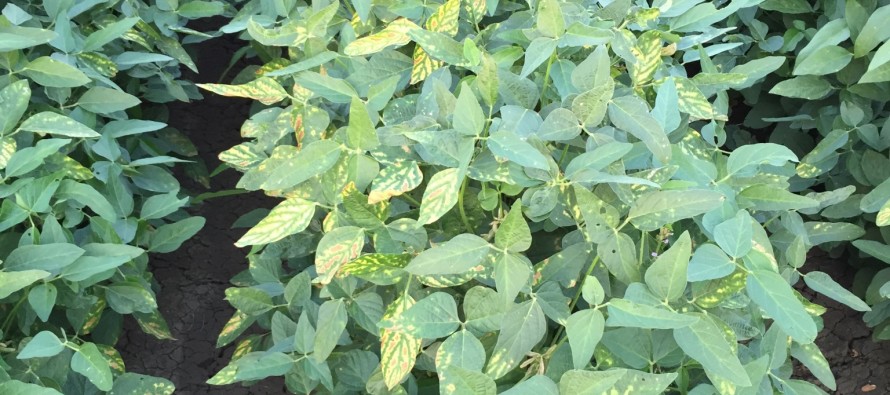Soybean disease update: July 31, 2015

Related Articles
- 2010 Soybean And Corn Variety Trial Data 3
- Rice Variety Trial Results For 2010, Plus Rice Research Report 0
- Evaluation of Peanut Prescription Rx Program in Mississippi 0
Latest Tweets
Over the past two seasons the number of fields where Anthracnose lesions have been observed on plants has increased. Generally deeper in the plant canopy, pods with sunken, brown, circular lesions can be observed. However, over the past two seasons lesions on pods have also been observed in the upper most part of the plant canopy. Protecting pods in the upper part of the plant canopy is important. But, given the current temperatures and lack of rainfall I do not see the season moving into the plant canopy of many fields. So far this season three fields have been observed to have limited anthracnose pod rot. Scout for the presence of the lesions on pods in the upper most plant canopy. But be mindful that some insect feeding can product similar lesions and if dark pepper grains are present within the pod tissue then anthracnose pod rot is more likely than insect feeding.

Cercospora leaf blight can produce a bronzing of leaves as well as purpling of leaves, pods, and petioles.
Cercospora blight
High temperatures and excessive amounts of sunlight can increase the observable symptoms associated with Cercospora blight. Leaf tissue that looks burned at the tips, feels leathery to the touch, appears bronzed, or even purple to black is affected by Cercospora blight. Leaves, pods, petioles, and seed can all be affected by the fungus that causes Cercospora blight. Based on ratings collected over the past three seasons, slight levels of tolerance exist within the available soybean germplasm. However, all soybean varieties should be considered to be susceptible to Cercospora blight. Over the past several seasons Cercospora blight appears to have become worse in the MS soybean production system. Fungicides are likely only moderately beneficial on this particular disease. Based on reports from Louisiana, the fungus that causes Cercospora blight is resistant to the strobilurin as well as MBC (thiophanate-methyl) fungicides. What this means for farmers in MS is that the general fungicide application that has been made for several years likely slows the fungus down a little and only delays the observation of symptoms. Once the typical symptoms associated with the disease are observed, making a fungicide application will not be beneficial.
Even given the current environmental conditions (high temperatures in particular), the frogye leaf spot calls have increased. Over the past two weeks, the observable frogeye leaf spot in fungicide trials in Stoneville has tremendously increased. In plots where FLS could barely be identified 14 days ago (approximately R3) the disease has increased threefold in most cases and is easily observed, even in fungicide-treated plots (now at R5). Make sure you are aware of the variety planted before choosing a fungicide product. Frogeye leaf spot in situations where fungicides are applied will continue to increase, particularly if a stand-alone strobilurin (QoI) fungicide is applied. However, the disease will also increase in the presence of a triazole (curative; DMI) fungicide. In situations where the disease is observed on R6 soybean a fungicide application is most likely not beneficial for yield loss prevention. Soybean fields that contain frogeye leaf spot susceptible soybean varieties should be observed frequently to reduce the risk of yield loss as a result of the disease. Fungicide applications at R5 and R5.5 in the presence of frogeye on susceptible soybean varieties have been economically beneficial and preventing yield loss.
For more information regarding fungicide trials conducted in MS over the past few seasons refer to:
Phytotoxicity
Given the high temperatures encountered over the past several weeks, I am not surprised that the calls regarding phytotoxicity are on the rise. In some cases fields have been treated with fungicides that produce a minimal (or no injury) as a result of the fungicide applied. However, I have received some telephone calls this year whereby a phytotoxic response was observed with a fungicide that has not been reported to result in that type of injury, but when tank mixed with another product a phytotoxicity event was observed. Keep in mind, that some products on their own will produce an injury to the soybean plant. When some additional tank mix products (e.g., boron) are mixed with a fungicide that tends to produce phytotoxicity be aware that excessive phytotoxicity can result. Over the past three seasons the observed phytotoxicity has been recorded that has resulted from fungicides that produced the injury. For more information on the specific products from the past several seasons that have resulted in foliar phytotoxicity, refer to: https://www.mississippi-crops.com/2015/07/22/diagnosing-fungicide-phytotoxicity-and-telling-apart-from-root-diseases/
Keep in mind, that during periods of hot, humid weather, the phytotoxicity that follows a fungicide application can appear severe. Plots in Stoneville have not appeared to have this much phytotoxicity as a result of specific fungicides since 2013.
Soybean rust
No soybean rust has been observed in MS to date. In fact, given the extreme temperatures over the past month, no new reports of soybean rust have been made from adjacent states. Hot, dry conditions are not conducive for the development of this disease. Sentinel plots continue to be monitored throughout MS.







Let me tell You a sad story ! There are no comments yet, but You can be first one to comment this article.
Write a comment